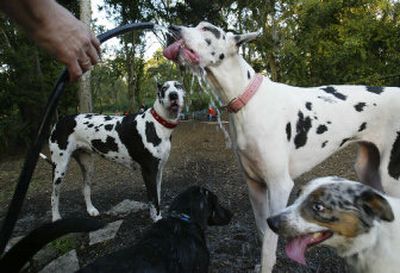Bloating in animals can be fatal

GASTRIC DILATATION –VOLVULUS, or GDV, often referred to as bloat, is a serious danger and is of the No. 2 cause of death (after cancer) for several large and giant breed dogs with deep chests like the Akita, bloodhound, collie, Great Dane, Irish Setter, Irish Wolfhound, Newfoundland, rottweiler, St. Bernard, standard poodle and Weimaraner. All deep-chested breeds, either purebred or mixed breed, are also at higher risk.
Bloat occurs when the stomach fills with food, water, and/or air. This results in an increased pressure that blows the stomach up like a balloon and eventually causes it to rotate or twist into an abnormal position. Like twisting the neck of a balloon to tie it off, the turgid stomach has the ends crimped, which in turns shuts off gastric input (can’t eat or drink) and output (can’t get rid of stomach contents). The blood supply is also compromised causing a serious cascade of events that causes about a quarter of bloat patients to die.
“Symptoms of bloat include acute abdominal pain, difficulty breathing, and retching with no vomit produced. As the stomach swells, the dog finds it harder to breath and the retching action increases the trapped air, causing more swelling,” says Will Novak, DVM, MBA, DABVP, and chief medical officer of Banfield, The Pet Hospital. “The condition, if untreated, leads to shock and the patient will collapse.”
Canine bloat is an emergency condition: If you don’t release the pressure on the stomach and blood vessels, it becomes rapidly fatal.
Larry Glickman, VMD, Ph.D., a professor of epidemiology at Purdue University School of Veterinary Medicine and director of clinical research at Data Savant did a study on canine bloat in which he followed nearly 2,000 dogs for up to five years to help identify risk factors. In addition to certain breeds being at greater risk of bloat, Glickman found out:
Age – older dogs are at a much higher risk with the risk going up 20 percent each year after the age of 5 in large-breed dogs and 20 percent each year after the age of three in giant-breed dogs.
Sex – the risk of bloat is slightly higher in males.
Weight – lean dogs were more at risk than overweight dogs.
Speed eaters – faster eaters are at higher risk for developing bloat, likely due to increased swallowing of air.
Height of bowl – elevated food bowls increase risk when this practice was previously thought “preventive.”
Frequency of feeding – dogs fed one large meal per day were at higher risk with the theory being the stomach was weighed down and stretched.
As well as finding reasons for increased risks, Glickman’s study disproved several theories for increased bloat risks that vets had bought into including: exercise before and after eating, timing or volume of drinking, vaccination status or feeding a particular brand of food.
More research into the food aspect of bloat led by principal author Dr. Malathi Raghavan published in the January/February 2006 issue of the Journal of the American Animal Hospital Association shows that feeding cereal-based ingredients in at-risk dogs does not increase their chances of developing bloat.
Previously it had been thought that cereal-based dry foods (main protein sources being corn, soy, wheat, rice) caused a higher risk than animal-protein based foods (beef, chicken, lamb).
The study did show that dry foods that list fats or oils among the first four ingredients (ingredients are always listed in decreasing percent of overall weight) were associated with a 2.4-fold increased risk of bloat. The study article is available online at www.jaaha.org.
If you have one of the breeds most at risk or have any deep-chested breed, you should talk with your veterinarian about what kind of food to feed, divide meals into 2 or 3 meals a day, and perhaps even take more drastic steps like a preventive gastropexy where the stomach is surgically secured to the body wall to prevent rotation. Glickman and others also found that if a dog bloats and does not have a gastropexy, the chance of it bloating again and possibly dying is nearly 100 percent within the next year. However if they have a gastropexy as soon as possible after bloating, the chance of the dog bloating again is small, less than 5 percent.
Bloat is treatable if caught early and reoccurrence is largely preventable. For more information about the prevention and treatment of bloat, contact your local veterinarian or visit www.banfield.net.